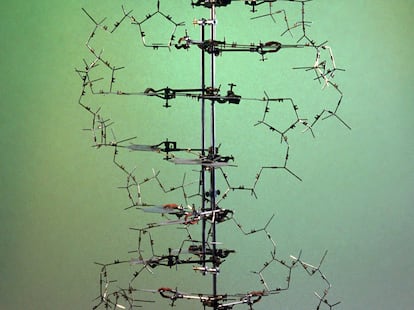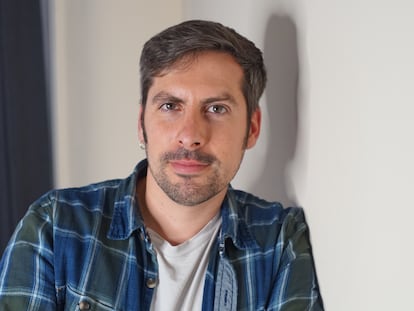DNA: How the secret of life was discovered 70 years ago
Letters and scientific articles by James Watson and Francis Crick tell the history of the double helix scientific breakthrough that defined the 20th century, and credit the contributions of Rosalind Franklin and Maurice Wilkins
It was one of the most important news stories of the 20th century, but no newspaper, radio or television reporters covered the discovery of the structure of DNA 70 years ago, on April 25. But the main characters didn’t need reporters to sell their story. “We have discovered the secret of life,” declared Englishman Francis Crick as he burst into a Cambridge (UK) bar and hugged James Watson, his American scientific partner. Two months after this unconventional scoop, Watson and Crick made the formal announcement in Nature. With little fanfare, the prestigious scientific journal published their article describing how they solved a puzzle that had baffled biologists for decades: how do children inherit genes from their parents?
In 1953, deoxyribonucleic acid (DNA) was already well known to scientists. Several experiments with bacteria in the 1940s had shown that genes are made of DNA, but even the scientists involved in these discoveries didn’t think it was the molecule of life. It seemed too simple, too mundane. Some scholars even regarded DNA as a “stupid molecule” consisting simply of a long chain of endlessly repeating tetrads of the same four nucleotides (A, C, G and T).
Most expected to discover that genes were also made of proteins, which are much more complex molecules. But a few researchers thought that the secret of DNA might lie in its structure. The idea of twisted spirals (helices) of DNA strands floated around scientific circles, but it was Watson and Crick who figured it all out.
Watson and Crick’s short paper published in Nature (April 1953) presenting the double helix structure completely changed how DNA was viewed. It was no longer a mundane molecule because that structure allowed an infinite variety in the sequence of A, C, G and T units within a very long chain. In fact, it is two complementary chains that are mirror images of each other.
The double helix was not only astonishing in its beauty and simplicity but also because that DNA structure revealed a lot about its function: it could enclose and protect very long messages and also had a mechanism for self-replication. The molecule, once known as the “stupid” one, was the perfect vehicle for genetic information.
A month before the paper was published in Nature, Francis Crick wrote his 12-year-old son a tender and emotional letter about the discovery. “Now we believe that the DNA is a code. That is, the order of the bases (the letters) makes one gene different from another gene (just as one page of print is different from another). You can now see how Nature makes copies of the genes. Because if the two chains unwind into two separate chains, and if each chain then makes another chain come together on it, then because A always goes with T, and G with C, we shall have two copies where we had one before.” In his letter, Crick wrote boldly about the discovery of the double helix, a forcefulness that was largely absent in their paper.
A visionary idea: genetic information
A bigger scientific bombshell was dropped in a more extensive paper published in Nature six weeks later. “The precise sequence of the bases is the code that stores genetic information,“ wrote Watson and Crick. This one sentence sums up the genius and visionary nature of this scientific partnership, writes Matthew Cobb in his book, Life’s Greatest Secret. Genetic information — no one had used those two words together before. It was a concept that Watson and Crick had just invented. The words sounded strange but also familiar, because they aligned so neatly with other ideas floating around the scientific community, which immediately accepted the discovery.
While scientists buzzed with excitement about the answer to biology’s big question, the public completely missed the news. England was celebrating major events that year, like the coronation of Queen Elizabeth II and the first ascent to the summit of Mt. Everest. Only one British newspaper, the News Chronicle, published a brief article titled “Nearer the Secret of Life” in May 1953, quoting Watson and Crick’s boss at Cambridge University, Sir Lawrence Bragg. “They have found the structure of the chemical which transmits — from one generation to another — inherited characteristics like the color of the eyes, the shape of the nose and even intelligence… Discovering how these ‘chemical’ cards are shuffled and paired will keep the scientists busy for the next 50 years.”
The discovery of the double helix launched a scientific revolution that culminated in 2003 with the complete sequencing of the human genome. Both milestones are now commemorated around the world on April 25, and today marks their 70th and 20th anniversaries, respectively. The United States has designated April 25 as National DNA Day.
Seeing invisible molecules
Watson and Crick remained virtually unknown because of scientific egos and the controversial method they used to develop the double helix model. The first newspaper report didn’t even mention their names and only said the discovery had been made by two teams of young scientists using X-rays in Cambridge and London. The London team comprised Maurice Wilkins and Rosalind Franklin, who conducted all the experiments. DNA strands are so thin that they were impossible to see under the microscopes available in the 1950s, and only modern electron microscopes can view them. To identify their structure, Wilkins and Franklin used X-ray photographs called X-ray diffraction patterns to determine the shapes of the molecules.
Wilkins and Franklin were leading experts in X-ray diffraction, and their laboratory at King’s College London provided crucial images and data for Watson and Crick to deduce the DNA double helix and its structure. The two teams collaborated for almost two years, and in 1951 it was Rosalind Franklin who disproved Watson and Crick’s first attempt at creating a DNA model — the triple helix. Franklin showed how the model was chemically impossible and produced upside down strands, contrary to the results of their experiments.
After that failure, Sir Lawrence Bragg ordered Watson and Crick to stop working on DNA, but changed his mind a year later when he learned that Linus Pauling, his American arch-rival, was about to announce his solution to the problem. Bragg encouraged Watson and Crick to resume their research and win that scientific prize for the University of Cambridge’s Cavendish Laboratory. Meanwhile, the London team’s working relationship was falling apart and Rosalind Franklin asked to be transferred. Watson and Crick worked at a frantic pace, making multiple DNA mockups with pieces of cardboard and metal. After fitting the pieces together, they made mathematical calculations to see if the positions were viable. Now working separately, Wilkins and Franklin continued to provide the X-ray diffraction data that helped Watson and Crick solve the puzzle.

Foul play in the final sprint
Controversy arose because Watson and Crick never directly asked their colleagues for the data, never said what it was used for, and didn’t inform them of their progress on the double helix until it was finished. They informally obtained the preliminary, unpublished data from their bosses and didn’t share the limelight with Wilkins and Franklin, except for a brief mention at the end of their paper. Not illegal, but certainly not proper scientific etiquette.
Watson was reluctant to be interviewed in 1953 because he believed more research was needed to confirm the double helix and feared being publicly accused of stealing data, wrote his biographer Victor K. McElheny in Watson and DNA. But neither Maurice Wilkins nor Rosalind Franklin ever made that accusation. Watson and Crick continued to expand their theory and provided much more credit to Wilkins and Franklin in a paper published in 1954. “We are most heavily indebted in this respect to the King’s College Group, and we wish to point out that without this data, the formulation of our structure would have been most unlikely, if not impossible.” They also acknowledged that the details of their X-ray photographs were not known to them, and that the formulation of the structure was largely the result of extensive model building.
The double helix is an iconic scientific achievement analogous to the Mona Lisa of biology. The race to understand genetic inheritance began in 1869 when DNA was discovered and the following 70 years produced many important discoveries. But a crucial piece of the puzzle was missing. Two years of hard collaboration changed the history of science, despite the squabbles, interruptions and subterfuge. The precise experiments conducted by Wilkins and Franklin, combined with the theoretical acumen of Watson and Crick, helped the four scientists understand and apply the contributions of earlier researchers.
1869
Discovery of nuclein (DNA): Friedrich Miescher finds a substance rich in phosphorus and nitrogen in the nucleus of cells. Its function is unknown, and he calls it “nuclein.”
1876
Sexual reproduction under the microscope. Oscar Hertwig sees how the sperm penetrates the ovum and how their nuclei fuse. He later suggests that nuclein is the substance responsible for the inheritance of biological traits.
1880s
Chromosomes and cell division. Wilhelm von Waldeyer-Hartz first uses the term “chromosomes” for the colored bodies that appear in the nucleus during cell division, previously described by Walther Flemming.
1902
Chromosomal theory of inheritance. Theodor Boveri and Walter Sutton explain the mechanisms of the laws of genetics, discovered in 1865 by an Austrian monk named Gregor Mendel, who experimented with pea plants.
1909-1929
The chemical composition of DNA. Phoebus Levene studies the composition of the nuclein discovered by Miescher and names it deoxyribonucleic acid (DNA).
1915
Genes are in chromosomes. Thomas Hunt Morgan experiments with fruit flies and shows that genes are in specific places on chromosomes, confirming the Boveri-Sutton theory.
1944
DNA is the carrier of genes. An experiment by Avery, MacLeod and McCarty confirms that DNA is the substance that causes a genetic alteration in bacteria.
1950
Bases are paired. Erwin Chargaff discovers that DNA always contains the same proportion of adenine (A) to thymine (T), and cytosine (C) to guanine (G). Their composition varies from one species to another.
1952
Photo 51: the best X-ray of DNA. Raymond Gosling and Rosalind Franklin produce a very sharp X-ray diffraction image of DNA. It conclusively proves that the molecule has helices.
1953
The double helix. James Watson and Francis Crick develop their model of the structure of DNA. X-ray data from Rosalind Franklin and Maurice Wilkins confirms its accuracy.
1957
The principle of molecular biology. Francis Crick continues to expand the theory of genetic information and develops its central principle: information is transmitted from DNA to RNA, and from RNA to proteins.
1960s
The genetic code. Marshall Nirenberg and Severo Ochoa, among others, decipher the mechanisms by which the DNA code is transcribed to make proteins. The double helix theory is definitively confirmed.
Sign up for our weekly newsletter to get more English-language news coverage from EL PAÍS USA Edition

